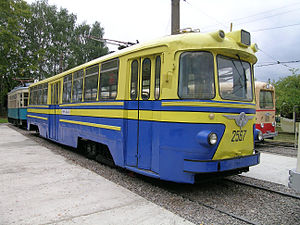
The LM-57 (Russian ЛМ-57) is the Soviet motor four-axle tramcar. First prototype of this vehicle was built in 1957 (hence the 57 in the name) at the Leningrad Wagon Repair Plant (VARZ, ВАРЗ, Ленинградский Вагоноремонтный Завод - Russian abbreviature and full name). "LM" means Leningrad Motor tramcar. The VARZ produced nearly 800 LM-57s in 1957–1968.
The LM-57 has streamlined forms, which were common for vehicles in many countries in the end of the 1950s. First LM-57 also had a big number of chromized parts and a big front emblem but, the mass production LM-57 had fewer decorations tram forever. The LM-57 had a nickname Stilyaga (Russian Стиляга), meaning The Dandy for its external appearance.
LM-57 tramcars worked in Leningrad, Kiev, Tashkent, Gorky, Magnitogorsk, Kazan, Saratov, Arkhangelsk and Nizhny Tagil. The last LM-57s were withdrawn from city service in 1983–85. Unlike LM-49 withdrawal, many LM-57s were on the edge of complete exhaustion at this time. This was a consequence of metal economy policy, started in the beginning of the 1960s. Main goal of such policy was maximum increase of tramcar mass production. As a result, the frame of LM-57 was not strong and durable in comparison with less complicated pre-war and first post-war tramcars.